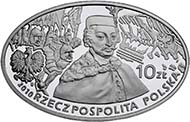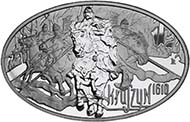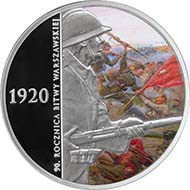August 26th, 2010 – On July 1st and 2nd the Polish mint issued two news coins belonging to a new series: The first is dedicated to the Battle of Grunwald (Battle of Tannenberg), the second to the Battle of Klushino.
Poland. 10 Zloty, Mint of Poland / Warsaw, design: Robert Kotowicz, date of issue: July 1st, 14,4 g silver 925/1000, diameter 32 mm (oval); mintage: 60.000.
Battle of Grunwald
The battle of Grunwald [Battle of Tannenberg], fought on 15 July 1410, was one of the greatest such developments in medieval Europe. The Polish and Lithuanian forces under the command of King W?adys?aw Jagie??o consisted of approximately 45,000 armed soldiers, mainly cavalry. The Teutonic Knights, headed by the Grand Master Ulrich von Jungingen, had about 16,000 cavalrymen and 5,000 of infantry.
The moment when the battle commenced was chosen by the Polish king. Jagie??o purposefully delayed the combat and thus tired the Teutonic Knights, who had been standing in the battle order from the morning. at about noon, the battle began with two shots from the Knights’ cannons, and the Lithuanian and Ruthenian troops clashed with the heavily-armed Teutonic cavalry after wiping out the artillerists. After an hour of fight, the Lithuanians darted away, which in all probability was an intentional manoeuvre meant to lure the left wing of the Teutonic army into an ambush. The hypothesis seems to be confirmed by the Lithuanian troops’ later return to the battlefield and their obliterating the enemy soldiers, dispersed in a disorderly chase.
The main forces of the Crown entered the battle with some delay. In accordance with the tactic of the time, individual units and companies were formed in deep columns, preceded by a “wedge” consisting of the best knights. Such an order offered extensive possibilities of manoeuvre and helped withdraw the companies after a failed charge as well as provide new lances to replace those worn out in combat.
After a six-hour combat, the Poles, supported by the returning Lithuanian troops of Duke Witold, circled the Teutonic army. Ulrich von Jungingen and many Teutonic dignitaries fell in the battle, and the Teutonic troops were put to flight in panic. The Teutonic camp, surrounded by wagons, was taken by storm.
After the battle, the troops headed for Malbork, which at the time was an impenetrable fortress. After a short and vain siege, Jagie??o’s army returned to Poland.
The result of the battle of Grunwald was the peace agreement concluded in Toru? in 1411. Although its terms were incommensurable with the victory, it satisfied Poland and Lithuania, as it gave them the territories for which the war had been waged.
Poland. 10 Zloty, Mint of Poland / Warsaw, design: Robert Kotowicz, date of issue: July 1st, 2010, 14,4 g silver 925/1000, diameter 32 mm (oval); mintage: 60.000.
Schlacht von Klushino 1610
The battle of Klushino was the apogee of the nine-year Polish-Muscovite conflict. Pursuing the dynastic plans of King Sigismund III Vasa, Poland engaged in an open conflict with its eastern neighbour. The support which King Charles IX of Sweden provided to the tsar made King Sigismund III begin a military action in the territory of the Moscow state in September 1609. The first goal was to capture Smolensk. In May 1610, the tsar started preparations to rescue the town – he gathered over 30,000 troops under the command of his brother Dmitri Shuisky, and 8,000 of foreign allies, headed by Jacob de la Gardie, who marched to Klushino and set up a fortified camp. The Polish army of 7,000 men led by Hetman Stanis?aw ?ó?kiewski, mostly cavalry, i.e. hussars and Cossacks with lighter arms, began their march towards the camp. On 4 July 1610, after a whole night of marching, they reached Klushino.
As dawn broke the hussars attacked the left wing of the Muscovite army. One strike followed another, as after a clash the troops would withdraw to make way for the charge of the next company. Hours of bloody battle passed and continuous attacks of the cavalry brought no result. Then, an attack was unleashed on the right wing of the Muscovite army, consisting of foreign troops which fiercely resisted.
The sustained charges, in which Hetman Zolkiewski tied all his forces, finally brought the desired result: Dmitri Shuisky eventually decided to use his reserves – reiter cavalry using the so-called caracole. The tactics meant that each unit approached the enemy as closely as possible and then its first row would fire from pistols and withdraw to the back of the unit so that another row could fire. The moment was used by the Polish army – only the first row had the time to fire when the hussars caught the reiters. The impetus of the charge pushed them towards the remaining troops. The further charge of the hussars broke the resistance of the Muscovite army, whose tight mass began to give ground, and the Muscovite camp was taken. Thanks to the coordinated charge of the infantry, shellfire and cavalry strikes, Moscow’s defence on the right wing was broken. The foreign infantry withdrew from combat, hiding in the forest and in their camp. After approximately five hours of combat Zolkiewski was the master of the battlefield.
Ss a result of the battle, the boyars elected Polish Prince Wladyslaw the Russian tsar and Hetman Zolkiewski seized Moscow.
Written by Witold Glebowicz
Polish Military Museum in Warsaw
Poland. 20 Zloty, Mint of Poland / Warsaw, date of issue: August, 28,28 g silver 925/1000, diameter 38,62 mm; mintage: 50.000.
In August, another commemorative coin dedicated to a battle will be issued. It recalls the Battle of Warsaw better known as the “miracle at the Vistula”.
If you want to learn more, click here.
You can order the coins at
http://www.mennica.com.pl/en/main-page.html










